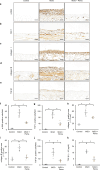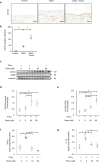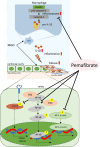Selective activation of PPARα by pemafibrate mitigates peritoneal inflammation and fibrosis through suppression of NLRP3 inflammasome and modulation of inflammation
- PMID: 39394435
- PMCID: PMC11470028
- DOI: 10.1038/s41598-024-74340-5
Selective activation of PPARα by pemafibrate mitigates peritoneal inflammation and fibrosis through suppression of NLRP3 inflammasome and modulation of inflammation
Abstract
Peritoneal inflammation and fibrosis remain major challenges to the long-term maintenance of peritoneal dialysis. Pemafibrate, a selective peroxisome proliferator-activated receptor α (PPARα) modulator, has been implicated in the management of fibrosis-related disorders. We investigated whether pemafibrate ameliorates peritoneal inflammation and fibrosis and explored the underlying mechanisms in mice with methylglyoxal (MGO)-induced peritoneal fibrosis (MGO mice). MGO mice exhibited peritoneal fibrosis with increased expression of mesenchymal markers, transforming growth factor-β1 (TGF-β1), and substantial deposition of extracellular matrix (ECM) proteins. Additionally, MGO mice exhibited peritoneal inflammation as indicated by elevated tumor necrosis factor-α expression and macrophage infiltration in peritoneal tissue. These effects were mitigated by pemafibrate treatment, which also restored peritoneal membrane function. Furthermore, pemafibrate promoted anti-inflammatory macrophage polarization in both mice and THP-1 cells. In human peritoneal mesothelial cells (HPMCs), pemafibrate effectively inhibited interferon-γ-induced production of TGF-β1 and ECM while suppressing the proinflammatory cytokines nuclear factor-κB (NF-κB) and activator protein 1. The NF-κB inhibitory effect of pemafibrate involved stabilization of the NF-κB inhibitory protein IkBα. Notably, pemafibrate hindered activation of the NLR family pyrin domain containing 3/caspase-1 axis in interferon-γ-stimulated THP-1 cells. These findings suggest that pemafibrate ameliorates peritoneal inflammation and fibrosis, making it a promising candidate for peritoneal fibrosis therapy.
Keywords: Inflammasome; PPARα; Peritoneal dialysis; Peritoneal fibrosis; Peritoneal inflammation.
© 2024. The Author(s).
Conflict of interest statement
The authors declare no competing interests.
Figures








Similar articles
-
Pemafibrate attenuates pulmonary fibrosis by inhibiting myofibroblast differentiation.Int Immunopharmacol. 2022 Jul;108:108728. doi: 10.1016/j.intimp.2022.108728. Epub 2022 Apr 6. Int Immunopharmacol. 2022. PMID: 35397395
-
Hepatocyte growth factor ameliorates methylglyoxal-induced peritoneal inflammation and fibrosis in mouse model.Clin Exp Nephrol. 2021 Sep;25(9):935-943. doi: 10.1007/s10157-021-02067-y. Epub 2021 Apr 28. Clin Exp Nephrol. 2021. PMID: 33909175
-
Paricalcitol attenuates TGF-β1-induced phenotype transition of human peritoneal mesothelial cells (HPMCs) via modulation of oxidative stress and NLRP3 inflammasome.FASEB J. 2019 Feb;33(2):3035-3050. doi: 10.1096/fj.201800292RR. Epub 2018 Oct 24. FASEB J. 2019. PMID: 30354670
-
Genetic and Epigenetic Regulation of the Innate Immune Response to Gout.Immunol Invest. 2023 Apr;52(3):364-397. doi: 10.1080/08820139.2023.2168554. Epub 2023 Feb 6. Immunol Invest. 2023. PMID: 36745138 Review.
-
Gene Expression Profiles Induced by a Novel Selective Peroxisome Proliferator-Activated Receptor α Modulator (SPPARMα) Pemafibrate.Int J Mol Sci. 2019 Nov 13;20(22):5682. doi: 10.3390/ijms20225682. Int J Mol Sci. 2019. PMID: 31766193 Free PMC article. Review.
Cited by
-
Dietary Polyunsaturated Fatty Acid Deficiency Impairs Renal Lipid Metabolism and Adaptive Response to Proteinuria in Murine Renal Tubules.Nutrients. 2025 Mar 10;17(6):961. doi: 10.3390/nu17060961. Nutrients. 2025. PMID: 40289946 Free PMC article.
-
Proteomic profile of human sinoatrial and atrioventricular nodes in comparison to working myocardium.Sci Rep. 2025 Feb 28;15(1):7238. doi: 10.1038/s41598-025-89255-y. Sci Rep. 2025. PMID: 40021668 Free PMC article.
-
Methylglyoxal-Stimulated Mesothelial Cells Prompted Fibroblast-to-Proto-Myofibroblast Transition.Int J Mol Sci. 2025 Jan 19;26(2):813. doi: 10.3390/ijms26020813. Int J Mol Sci. 2025. PMID: 39859527 Free PMC article.
-
Targeting MLL1/WDR5-Mediated Epigenetic Regulation Mitigates Peritoneal Fibrosis by Reducing p16INK4a.FASEB J. 2025 Apr 30;39(8):e70543. doi: 10.1096/fj.202402382R. FASEB J. 2025. PMID: 40232893
-
Integrated serum metabolomics and network pharmacology reveal molecular mechanism of Qixue Huazheng formula on peritoneal fibrosis.Front Pharmacol. 2025 Jan 23;16:1515038. doi: 10.3389/fphar.2025.1515038. eCollection 2025. Front Pharmacol. 2025. PMID: 39917615 Free PMC article.
References
-
- Devuyst, O., Margetts, P. J. & Topley, N. The pathophysiology of the peritoneal membrane. J. Am. Soc. Nephrol.21, 1077–1085 (2010). - PubMed
-
- Zhou, Q., Bajo, M. A., Del Peso, G., Yu, X. & Selgas, R. Preventing peritoneal membrane fibrosis in peritoneal dialysis patients. Kidney Int.90, 515–524 (2016). - PubMed
-
- Kawaguchi, Y. et al. Searching for the reasons for drop-out from peritoneal dialysis: A nationwide survey in Japan. Perit. Dial Int.23 (Suppl 2), S175–177 (2003). - PubMed
-
- Mizuno, M. et al. Peritonitis is still an important factor for withdrawal from peritoneal dialysis therapy in the Tokai area of Japan. Clin. Exp. Nephrol.15, 727–737 (2011). - PubMed
MeSH terms
Substances
LinkOut - more resources
Full Text Sources
Research Materials

